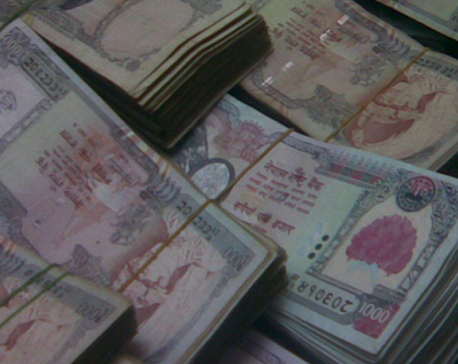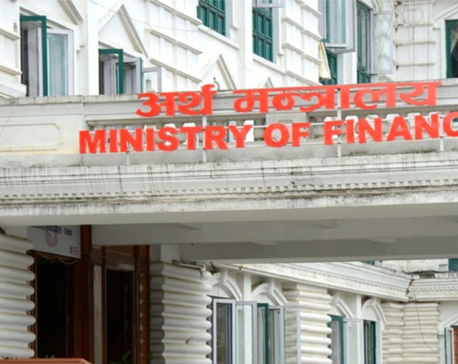
OR
Government lowers budget numbers but claims it will meet growth target
Published On: February 13, 2020 08:13 AM NPT By: RAJESH KHANAL
KATHMANDU, Feb 13: The government on Wednesday expressed its firm determination to achieve its target of economic growth after revising the earlier announced budget size and expected expenditures allocated for development works.
In a mid-term review of the annual budget, the government has reduced the total budget to Rs 1.38 trillion from Rs 1.53 trillion while also downsizing the capital expenditure to Rs 326.81 billion against the allocated amount of Rs 408 billion.
Stepping back from its announced annual expenditure target of Rs 1.53 trillion for 2019/20, the government has now revised the expenditure amount to 90.4% of the earmarked volume. Similarly, the capital expense target is now 80.1% of the Rs 408 billion allocated for construction of infrastructure.
Addressing a function organised by the Ministry of Finance to publish the findings of the mid-term budget review, Finance Minister Yuba Raj Khatiwada, however, reiterated his claim on meeting the target of economic growth this year. Despite the setback that the government faces in revenue collection and capital expenditure, Khatiwada has insisted on meeting the economic growth target against the backdrop of implementing investment-friendly laws, an expanding manufacturing sector, increased investment in infrastructure, speeded up reconstruction and expansion of the financial sector.
This is the second consecutive year that Finance Minister Khatiwada has revised the annual budget size. This year, the government is under even more pressure to meet the target of revenue collection and capital expenditure. Officials of the Finance Ministry however have been making futile claims about abiding by the government’s target for economic growth.
Khatiwada had forecast a growth rate of 8.5 percent when he presented the budget statement for the current fiscal year. International organizations such as the World Bank and the International Monetary Fund however claimed that the country’s growth rate will stand at 6.5-7%, way below the ambitious target of the government. But the ministry has stuck to its announced numbers.
Analysts said that the government claim to meet the growth target seems unrealistic. “As the capital expenditure is dismal, the government is trying to meet the target by increasing last hour expenses as the fiscal year approaches its end. Such action can help maintain a growth target statistically, but it will not help achieve sustainable growth and yield the desired results,” Dipendra Bahadur Chhetri, an economist, told Republica.
The ministry has also reviewed the revenue collection target to Rs 1.05 trillion from more than Rs 1.1 trillion. Statistics with the Financial Comptroller General Office (FCGO) show that the government collected only Rs 433.15 billion by mid-January, against the target of mobilizing Rs 537 billion. Failing to meet the revenue target, the government has reset the target at 95.6% of what was announced in the budget.
According to the ministry, until the first half of the current fiscal year, the government has spent only 15.4 percent of the targeted capital expenditure. The capital expenditure proportion that the government has made out this year is even less than that of the review period last year. By mid-January last year, the government’s capital expenditure amount had stood at 17.7% of the Rs 313.99 billion allocated under that head.
Revenue collection over the first six months stood at a mere 39% of the targeted tax revenue of more than Rs 1.1 trillion for this fiscal year. The shortfall in revenue collection comes as a setback to the government at a time when it is struggling to manage funds for increased expenditures under the federal system.
In the first six months, the government collected Rs 456.18 billion, which according to the ministry is 13.4% more than the revenue collection amount during the review period last year. “Although the revenue collection was hit by the fall in imports, revenue mobilization has increased by an encouraging 26%,” reads the ministry’s review document.
During the review period, the inflation rate stood at 6.4% compared to 4.2% during the same period last fiscal year. The ministry has attributed the high inflation rate to the hiked prices of a number of food items.
A check in the ever-expanding trade deficit and fall in the current account deficit have given some respite to the government. Over the review period, the country’s trade deficit went down by 6.1 percent to Rs 637.41 billion, export earnings increased by 26.1% and import expenses fell 4%.
Likewise, the current account deficit went down by half to Rs 82 billion. As a result, foreign currency reserves increased by Rs 57 billion to Rs 1.09 trillion, which is sufficient for the import of goods and services for the next 8.4 months.
You May Like This

Take austerity measures to tackle dwindling revenue collection
Nepal finds itself under the critical scrutiny of analysts and economists, who decry its inability to curtail unnecessary expenses in... Read More...

Govt remains incapable of raising capital expenditure
KATHMANDU, Jan 15: Due to procedural complications and complexities, the government is seen as incapable of spending capital expenditure. ... Read More...

Province 1 spends just four percent of development budget in 1st quarter
BIRATNAGAR, Nov 4: The capital expenditure of Province 1 in the first quarter of the current fiscal year (2076/2077) stood... Read More...








Just In
- NRB to provide collateral-free loans to foreign employment seekers
- NEB to publish Grade 12 results next week
- Body handover begins; Relatives remain dissatisfied with insurance, compensation amount
- NC defers its plan to join Koshi govt
- NRB to review microfinance loan interest rate
- 134 dead in floods and landslides since onset of monsoon this year
- Mahakali Irrigation Project sees only 22 percent physical progress in 18 years
- Singapore now holds world's most powerful passport; Nepal stays at 98th










Leave A Comment